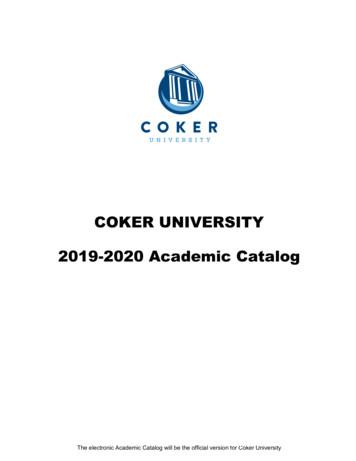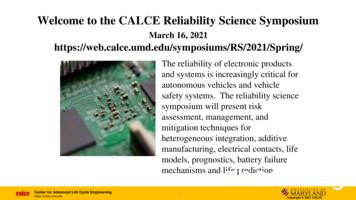Coker Safety And Reliability Lessons Learned
Coker Safety and ReliabilityLessons LearnedDale Wilborn2015 Coking.comConference 2015 Chevron
COKER SAFETY & RELIABILITYCurrent SituationThe Delayed Coker industryhas had many incidents withsevere consequences,including numerous fatalities.There has been greatprogress in the last 15 years toimprove Coker design toreduce personal exposure andimprove safety.Even with all theimprovement, Chevron hasexperienced some near missand operational reliabilityincidents. Current focus areasare metallurgy and Inspection.Near miss, Incidents and Lessons Learned Furnace OutletStart-up issuesLock out- tag out incidentErosion of thermowellErosion – Corrosion at elbowsErosion at velocity steam injection location Absorber- Stripper and DebutanizerTrace water causing reboiler corrosionTrace water causing vaporline corrosion PROCESS GAS SPONGE ABSORBERBLISTERINGHYDROGEN Delta Valve – 10 Year look back COKER Shutdown cleanup using RTIDesired Outcome Provide “lessons learned “ to raise awareness & increase focus on Coker safety and reliability. Highlight potential vulnerabilities, discuss inspection, training, and incident prevention. 2015 Chevron2
Coker Furnace Incidents Coker Startup Issues &Incident Furnace Pass Flow Meter Inadequate lock-out tag-out Furnace Outlet Barrel: OutletThermowell Erosion Furnace Transfer Line Erosion 2015 Chevron3
Coker Startup Issues & IncidentOVERVIEW* Charge pump cavitation* Loss of furnace flames 50% of burners1. Charge Coker with LCO, establish levels andpump circulation.2. Commission steam for Coker structure.3. Drain (multiple times) fuel gas linewith chemical cleaning liquid.4. Clean plugged furnace charge pumpsuction screens.5. During pump switch to electric,significant water hammer & pipingvibration. 2015 Chevronwater4
Coker Startup Issues & Incident6. Coke from piping caused furnace FCplugging; cleaned multiple control valves,establish flow control.7. Furnace warm-up, module circulation, feedin to coke drum.8. Furnace charge pump cavitation fromflashing seal flush.9. Low furnace pass flow, high furnace outlettemperatures, fuel gas TC closes; fuel gason new minimum flow.10.High CO and O2 in firebox; visualinspection of furnace shows multipleburners were not lit. Loss of flames withfuel gas into firebox is a HAZARDOUScondition. 2015 Chevron5
COKER XxXXXXXXXXXXXXXXXXXXXXXXXXXXXXXXXXXXXXXXXXX 2015 ChevronxxxxxxXErratic control, large furnace temperature swings.XXXXXXXXX6
Coker Startup Issues: Corrective Action1. Cleaned furnace charge pump suction screens.2. Changed the charge pump seal fluid from FCC LCO (with heavygasoline being dropped to LCO due to refinery processing constraints)to HCGO pumparound.3. Drain liquid from fuel gas headers.4. Re-light burners. NOTE: Low pressure Safety InstrumentedSystem (SIS) fuel gas chop function DID NOT activate becausethe pressure sensors are upstream of the TC.5. With oil flow and furnace burners re-established, returned to minimumflow at desired furnace outlet temperature.6. Since resid below coking temperature entered the coke drum, feedcycle time extended to increase coking time. Also, increased steamstripping time. There were no tarry drum issues during quench, drain,or coke removal. 2015 Chevron7
Coker Startup Issues: Corrective ActionMAINTENANCE1. Disconnect fuel gas flanges / open bleeders at low points to verify dry afterchemical cleaning.2. Inspect coke drum vaporlines, column bottoms piping; clean if necessary.OPERATIONS1. Use heavy gasoil, not FCC LCO for startup charge to Coker.2. FURNACEa. Review fuel gas minimum flow guidelines, increase to maintain adequateburner header pressure for flame stability.b. Develop short term emergency procedure for low fuel gas burner header pressurein lieu of SIS trip.c. Correct SIS fuel gas pressure measurement location.3. STRUCTURE STEAM. Wait until drum inlet temperature is over 700 F beforeintroducing structure steam (minimize potential for condensed water in system). 2015 Chevron8
Furnace Pass Flow Meter - Inadequate LockOut – Tag Out Poor communication regarding location of isolation between operatorreleasing equipment and mechanic doing the work on resid orificepass flow meter plugged tubing. Resid sprayed from furnace pass flow orifice meter. Resid at 550 F,500 psig furnace discharge pump pressure. Resid “auto-ignition”estimated to be 650F. 2015 Chevron9
Furnace Outlet Barrel: OutletThermowell ErosionOriginal Outlet barrel configuration: Steam:airdecoking caused thermowell erosion. Residleaking into the conduit caused false outlet reading,higher furnace firing rate, accelerated coking rate.Thermowells replaced, furnace de-coked.Outlet barrel configuration can be a source of cokeaccumulation. 2015 Chevron10
Furnace Transfer Line ErosionCHALLENGES1. Furnace transfer line is prone to coke accumulation, increasedpressure drop, higher velocity.2. Furnace outlet transfer line (especially elbows) is vulnerable toerosion and through wall “loss of containment”. The first elbow aboveoutlet barrel is especially vulnerable.Discussion Topic: Furnace transferpiping configuration 2015 Chevron11
Furnace Transfer Line Erosion 2011 – furnace outlet pipingerosion at outside of elbow after4 years. Coke in line increaseddownstream velocity. OPSdiscovered after spall, isolatedimmediately. 2013 – elbows flanged forremoval to clean, with stellitehard facing on inside.Furnace geometry: Outlet changed to maintainupward flow, no outlet barrel. 2015 Chevron12
Furnace Transfer Line Erosion Quench steamadded to furnaceoutlet from 6:00position. Lowersoutlet temperatureduring online spall.2015: Through wallerosion at 12:00position, slightlydownstream after 3-7years.Coke build-up on sidewalls results in highervelocity. 2015 Chevron13
Coker Distillation Incidents Absorber – Stripper Debutanizer 2015 Chevron14
Stripper CorrosionReboilerReturnChimney Tray 1 with corrosionfrom chlorides Corrosion – outside of reboiler (processside) tubes and shell 2015 ChevronChimney tray 1 afterrepairs15
XXXX.Stripper Repairs &PerformanceSHUTDOWN REPAIRS1. Replace tube bundles2. Repair reboiler shells.3. Add stainless steel over floor of total draw traythat feeds reboilers.XXXXCurrent Operation1. Gap control for absorber – stripper side waterdraw tray. Tray removes water, verypredictable. H2O removal from tray 13.2. Intermittent water from stripper bottoms todebutanizer.3. ISSUE: Determining if water is “trapped” belowH2O draw tray. Water vaporized leaves behindcorrosive chloride salts.XX 2015 Chevron
Debutanizer Condition Debutanizer tray 33, “Prussian blue” cyanide saltdeposits.Cause: Trace water in stripper bottoms was notbeing removed in debutanizer OH reflux drum.Water was being refluxed. After going down anumber of trays, the water was vaporized, leavingdeposits at the tray where vaporization occurred.Prior to shutdown, experienced column OH piping loss of containment.Corrosion from ammonium bisulfide accelerated by presence of cyanides. 2015 Chevron17
COKER SPONGE ABSORBERHYDROGEN BLISTERINGHISTORY1. Long history, no major issues.2. Water circulation with ammonium polysulfide (APS) injection is usedupstream of Sponge absorber.3. Additional nitrogen, increased ratio of APS per MBPD resid.4. Wet H2S service, but unexpected problem discovered in shutdown. 2015 Chevron18
Coker Sponge Oil Absorber Hydrogen Blistering Discovered Hydrogen blistering withcracks in the steel. Wet H2S andpossibly cyanides are root cause.No tray issues. Floating valve caps 2015 Chevron19
Coker Sponge Oil AbsorberRepairReplaced top 8 feet of Sponge Absorber.Maintained upstream sour watercirculation with APS to remove cyanidesfrom Coker tail gas.Discussion Topic: Determining if allcyanides in Coker tail gas have beenremoved. 2015 Chevron20
Automatic TOP and Bottom Unheading with DeltaValves – 10 Year Look back 2015 Chevron21
The old coke drum unheadingwas a SAFETY risk withpotential for personalexposure, and injuriesoccurred during mechanicaltop and bottom unheading. 2015 Chevron22
Bottom Unheading The new system hasrevolutionized the industry;there has been a dramaticimprovement in Coker Safety.CHEVRON EXPERIENCE – 10 Years14 coke drums 2015 Chevron No Loss ofContainment incidents. No SAFETY incidentsassociated with valveoperation.23
Top UnheadingAuto-switch cutting toolCut nozzle (2)Bore Nozzle (4)Delta Valve, fully automated, remoteoperation, no manual labor. 2015 Chevron24
Coker Shutdown Clean-Up with RefinedTechnologies Incorporated (RTI) 2015 Chevron25
Coker Shutdown Clean-Up with RefinedTechnologies Incorporated (RTI) Extensive pre-shutdownequipment installed toallow steam andchemical to be routed toall desired locations. Introduces trippinghazards. 2015 Chevron26
Upper Section Main FractionatorColumn entry with appropriate personalprotection equipment 2015 Chevron27
Coker SHUTDOWN CLEANUPTunnel column by removing tray deckmanways to allow inspection. Columncondition was very good, trays were veryclean. 2015 Chevron28
Coker SHUTDOWN CLEANUPSome coke and sludge onbottom HCGO chimneydraw tray 2015 Chevron29
Coker STARTUP ISSUEnNnnnnXXXXXXXXXXXXXXXXXXXXXXUpon startup, the overhead fin fan cooling performance wassignificantly worse.Lesson Learned: Column chemical cleaning needs to have OHXXXXXXXXXXXXXXXXXXexchanger cleaning to follow. 2015 Chevron30
Coker Safety and ReliabilityLessons LearnedQUESTIONS ? 2015 Chevron
significant water hammer & piping vibration. 4 OVERVIEW * Charge pump cavitation . Coker Sponge Oil Absorber Hydrogen Blistering Discovered Hydrogen blistering with . CHEVRON EXPERIENCE – 10
found the resurgence of Coker Creek in the time of the Civil War (1861-1865), as the place of a military encampment referred to as Camp Coker Creek. The endeavor was then to figure out the role that Coker Creek played in the War Between the States, and to connect, if proper to do so, the archaeological camp remains at 40MR708 with the Camp
Test-Retest Reliability Alternate Form Reliability Criterion-Referenced Reliability Inter-rater reliability 4. Reliability of Composite Scores Reliability of Sum of Scores Reliability of Difference Scores Reliability
Coker University is a student-centered, comprehensive university. It is dedicated to providing every . Undergraduate Day Program 7 Undergraduate Adult Degree and Online Programs 9 Graduate Program 11 INTRODUCING COKER UNIVERSITY 13 . Psychology 117 Sociology 119 Theatre 120 MASTERS PROGRAMS 124
TOPIC 12 Understand Fractions as Numbers 8 LESSONS 13 DAYS TOPIC 13 Fraction Equivalence and Comparison 8 LESSONS 12 DAYS TOPIC 14 Solve Time, Capacity, and Mass Problems 9 LESSONS 11 DAYS TOPIC 15 Attributes of Two-Dimensional Shapes* 5 LESSONS 9 DAYS TOPIC 16 Solve Perimeter Problems 6 LESSONS 8 DAYS Step Up Lessons 10 LESSONS 10 DAYS TOTAL .
Reliability Infrastructure: Supply Chain Mgmt. and Assessment Design for reliability: Virtual Qualification Software Design Tools Test & Qualification for reliability: Accelerated Stress Tests Quality Assurance System level Reliability Forecasting: FMEA/FMECA Reliability aggregation Manufacturing for reliability: Process design Process variability
Evidence Brief: Implementation of HRO Principles Evidence Synthesis Program. 1. EXECUTIVE SUMMARY . High Reliability Organizations (HROs) are organizations that achieve safety, quality, and efficiency goals by employing 5 central principles: (1) sensitivity to operations (ie, heightenedFile Size: 401KBPage Count: 38Explore furtherVHA's HRO journey officially begins - VHA National Center .www.patientsafety.va.govHigh-Reliability Organizations in Healthcare: Frameworkwww.healthcatalyst.comSupporting the VA’s high reliability organization .gcn.com5 Principles of a High Reliability Organization (HRO)blog.kainexus.com5 Traits of High Reliability Organizations: How to .www.beckershospitalreview.comRecommended to you b
Number of lessons (per week): 10 lessons (PT), 20 lessons (SI), 24 lessons (SIP), 30 lessons (INT) and 20 lessons 10 individual lessons (CC) Lesson duration: 50 minutes . Age: Minimum of 17 years old No maximum age requirement. Offered: Year-round . Courses Available: Part-time Course (PT) Semi-Intensive English Course (SI) Semi-Intensive Plus .
Agile Software Development with Scrum An Iterative, Empirical and Incremental Framework for Completing Complex Projects (Slides by Prof. Dr. Matthias Hölzl, based on material from Dr. Philip Mayer with input from Dr. Andreas Schroeder and Dr. Annabelle Klarl) CHAOS Report 2009 Completion of projects: 32% success 44% challenged 24% impaired Some of the reasons for failure: Incomplete .























